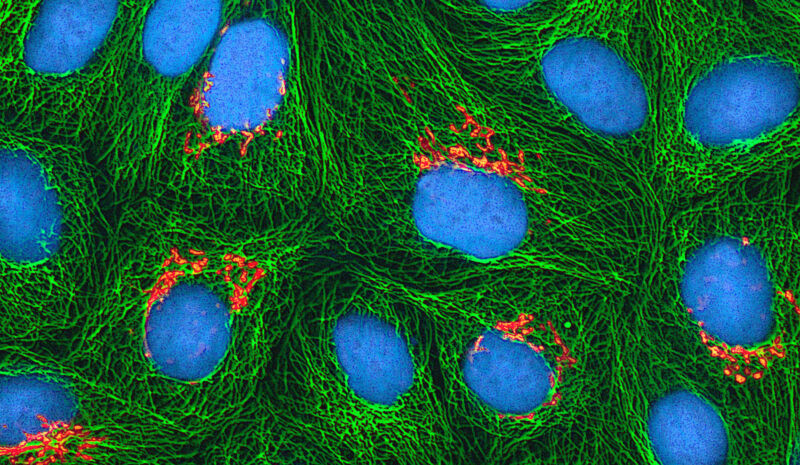Virus infected by quantum dot –
Viral path to cell nucleus tracked by injecting it with tiny glowing dot.
Tracking single virus particles is not exactly new. The idea is that you attach some sort of molecule that will glow to the virus. Then, you hit the sample with an exciting laser and look for glowing points of light. Optical microscopes can then track the virus’ location with very high precision.
With this sort of technology, you can learn a lot about how viruses move around. And if you make specific parts of the cell glow a different color, you can see how often the virus interacts with those parts (say a specific cell surface receptor) by how often the two glowing points merge into one.
One of the downsides is the glowing molecule on the virus, which is usually attached to the outer shell. In this case, the molecule may interfere with the normal activity of the virus. The virus may be prevented from entering a cell because the bolt cutter that it normally uses is blocked by the big glowing molecule you attached to it. Instead, putting the glowing bit of the virus on the inside, where it (hopefully) doesn’t change behavior, would be preferable.
On the inside
To get the quantum dot inside a virus, the researchers made use of the procedure by which a virus replicates. A virus storms a cell’s outer membrane and, once inside the outer defenses, makes its way to the inner ring of defenses (the membrane around the nucleus). After some persistent siege work, some viruses enter the cell nucleus where they can really get to work. These viruses hijack the cell’s replication machinery to turn out copies of their own DNA, while forcing the cell’s protein-making hardware to build new capsules. The cell, like some sort of sorcerer’s apprentice spell gone wrong, does this until it bursts open, spraying the contagion everywhere. The researchers interfered with this process by attaching some single stranded DNA to the quantum dot and, by various nefarious means, convinced the cell that the quantum dots belonged in the cell nucleus. To ensure that the dot got taken up by the virus, they used CRISPR / Cas9 to edit in a short stretch of DNA to the viral genome. The replacement DNA was complementary to the strand attached to the quantum dot, allowing them to base pair. So, during replication the quantum dot could be incorporated into the virus DNA. After which, the DNA, along with the quantum dot, got packaged up in the virus and ejected from the cell.Of course, not every virus particle contains a quantum dot, because the incorporation process is governed by the random chance of what bumps into what else inside the nucleus. However, the researchers managed to obtain enough labeled virus to perform some fun experiments. Shining a new light on old results
Because this is a new labeling technique, the researchers did not study anything particularly novel, but it showed that they could confirm results that were already known. They showed movies of viral particles entering cells and shooting along the cell’s microtubules network like they were on a subway system. The researchers could also see the virus entering the nucleus as well. The movies of their observations are available here.  / acs.nanolett.9b (
/ acs.nanolett.9b (
) (About DOIs )





GIPHY App Key not set. Please check settings